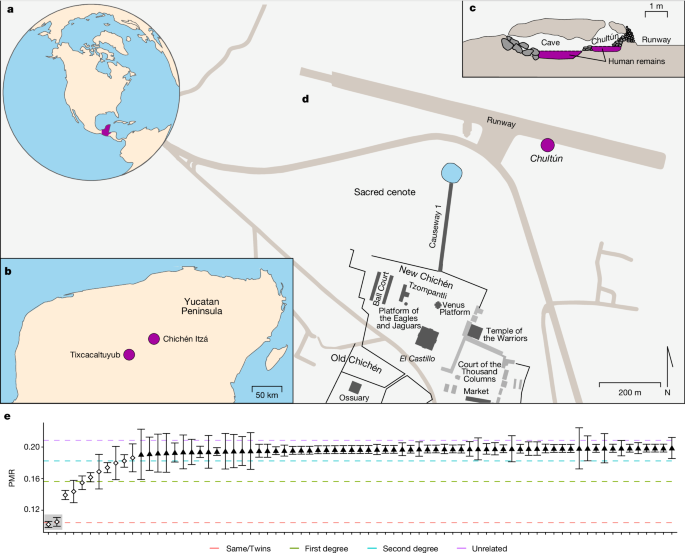Genetic Analysis Reveals Insights into Ritual Practices and Population Continuity at the Ancient Maya City of Chichén Itzá
Core Concepts
Genome-wide data from 64 ancient individuals found in a mass burial near the Sacred Cenote at Chichén Itzá provide insights into the ritual practices and genetic continuity of the ancient Maya population.
Abstract
The ancient Maya city of Chichén Itzá was a major center during the Late and Terminal Classic periods (AD 600-1000). This study presents genetic analysis of 64 subadult individuals found in a subterranean mass burial near the Sacred Cenote, the ceremonial center of Chichén Itzá.
Key insights:
All analyzed individuals were male, and several were closely related, including two pairs of monozygotic (identical) twins.
The presence of twins is significant, as they feature prominently in Maya and Mesoamerican mythology, embodying qualities of duality.
Genetic comparison to present-day regional populations shows genetic continuity, except at certain genetic loci related to human immunity, suggesting adaptation to infectious diseases introduced during the colonial period.
These findings provide new insights into the ritual practices and population dynamics of the ancient Maya inhabitants of Chichén Itzá.
Ancient genomes reveal insights into ritual life at Chichén Itzá - Nature
Stats
The study analyzed genome-wide data from 64 subadult individuals found in a mass burial near the Sacred Cenote at Chichén Itzá.
All analyzed individuals were male.
Several individuals were closely related, including two pairs of monozygotic twins.
Quotes
"Twins feature prominently in Mayan and broader Mesoamerican mythology, where they embody qualities of duality among deities and heroes, but until now they had not been identified in ancient Mayan mortuary contexts."
"Genetic comparison to present-day people in the region shows genetic continuity with the ancient inhabitants of Chichén Itzá, except at certain genetic loci related to human immunity, including the human leukocyte antigen complex, suggesting signals of adaptation due to infectious diseases introduced to the region during the colonial period."
Key Insights Distilled From
by Rodr... at www.nature.com 06-12-2024
https://www.nature.com/articles/s41586-024-07509-7
Deeper Inquiries
What other types of ritual practices or cultural beliefs might be revealed through further genetic analysis of ancient Maya burials?
Further genetic analysis of ancient Maya burials could potentially reveal more about the prevalence of certain genetic traits or markers associated with specific social or ritual roles within Maya society. For example, certain genetic patterns may be linked to individuals who held important ceremonial positions or who were involved in specific ritual practices. Additionally, genetic analysis could shed light on the presence of familial lineages or kinship structures within ancient Maya communities, providing insights into how these relationships were intertwined with religious or ceremonial activities. By examining the genetic data from a broader range of Maya burials, researchers may uncover patterns related to the inheritance of social status or the transmission of specialized knowledge or skills within these ancient societies.
How might the presence of closely related individuals, including twins, in this mass burial site challenge or expand our understanding of Maya social and kinship structures?
The presence of closely related individuals, particularly twins, in the mass burial site near the Sacred Cenote at Chichén Itzá challenges our understanding of Maya social and kinship structures by highlighting the significance of familial relationships and the potential role of kin-based groups within Maya society. The identification of monozygotic twins in this burial context suggests that these individuals held a special status or were accorded specific roles within the community, possibly related to their perceived spiritual or symbolic significance. This finding expands our understanding of Maya beliefs and practices surrounding twins, which are often associated with duality and supernatural powers in Mesoamerican mythology. The presence of closely related individuals in the burial site also indicates the importance of kinship ties and lineage connections in shaping social organization and community dynamics at Chichén Itzá, providing valuable insights into the complex network of relationships that structured Maya society.
What insights could be gained by comparing the genetic data from Chichén Itzá to other ancient Maya sites, and how might this inform our understanding of regional population dynamics and interactions?
Comparing the genetic data from Chichén Itzá to other ancient Maya sites can offer valuable insights into regional population dynamics, migration patterns, and interactions among different Maya communities. By analyzing genetic similarities and differences between individuals from various archaeological sites, researchers can trace the movement of populations, the exchange of genetic material, and the extent of genetic continuity or discontinuity across different regions. This comparative approach can help us understand the relationships between different Maya groups, the extent of cultural exchange and integration, and the impact of environmental or social factors on genetic diversity within the Maya civilization. Furthermore, by examining genetic data from multiple sites, researchers can reconstruct ancient population histories, identify genetic adaptations to local environments or diseases, and unravel the complex web of connections that linked Maya communities across Mesoamerica.
0
